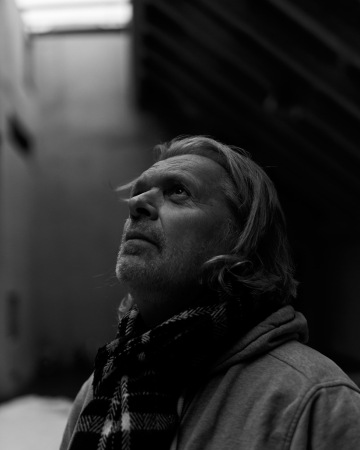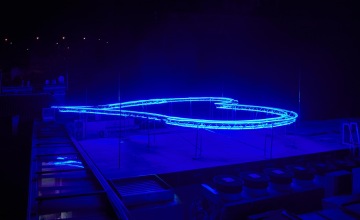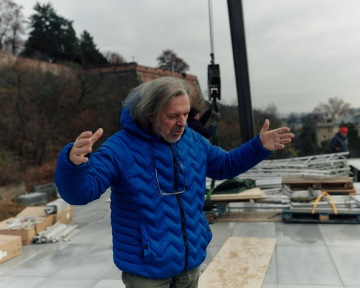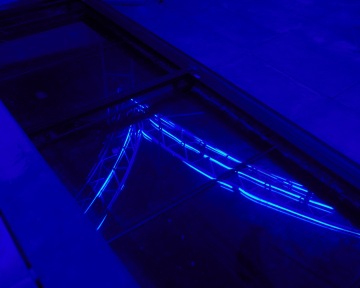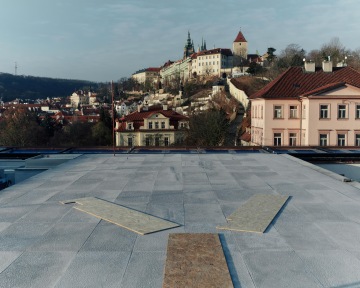Jiří David: The Blue Heart
On Sunday, 18 December 2022, the Blue Heart lit up over Kunsthalle Praha. The piece is a light installation made by Czech artist Jiri David. The event took place precisely on the day of the 11th anniversary of former president, playwright, and essayist Václav Havel's death.
Through this initiative, the Kunsthalle Praha is concluding an experimental platform called the Facade Project, which has enabled artists to create installations geared towards the front façade of the Kunsthalle Praha, which once formed the Zenger transformer substation.
With his so-called Third Neon Heart, creator Jiří David, who actively used this ambivalent heart symbol in his work throughout the 1980s, builds on his two previous light installations: specifically his Second Neon Heart that was presented at the European Parliament building in 2012 and, above all, his first pulsating red Neon Heart over Prague Castle, which was installed in 2002 on the south tower of the monastery of St. George on the castle grounds. The heart-shaped light installation consists of LED neon strips carried on an aluminium structure.
© Vojtěch Veškrna
"Thanks to its azure-bluish glow, the Third Neon Heart captures the same spirit and true essence of my two previous installations. I worked with this symbol in various forms and formats before at some point in the 1980's, and I tried to place its emptiness into a completely different context in 2002, which I was also successful in doing. The response around Neon Heart over Prague Castle was remarkable, whether it was negative or positive. Neon Heart above the Kunsthalle will now, in a way, become the ethos of Neon Heart over Prague Castle, levitating like a floating amoeba with a soft bluish glow," says artist Jiří David about the relationship between the current Neon Heart over the Kunsthalle and the famous original Neon Heart over Prague Castle, which he and Václav Havel officially lit up on 17 November 2002 from Café Slavia.
During the Velvet Revolution at the end of the 1980s, Václav Havel himself actively signed his name with a miniature heart, which went on to become an iconic symbol. Now nearly twenty years old, Jiří David's Neon Heart has proven to be an object open to interpretation. It can be seen as both a naive, kitschy emblem or a humanistic, spiritual symbol. The material Jiří David chose - LED neon strips - evokes contradictions; on the one hand, it resembles the world of advertising supporting consumerist culture and on the other, more radical art forms, be them conceptual or activist in nature.
However, according to the head curator of the Kunsthalle Praha, Christelle Havranek, the heart symbol is a direct reflection of Václav Havel's personality: "I think he was a very empathetic person, which is not very common within the political sphere. If he is respected around the world today, it's precisely because of this attribute, which manifested itself throughout his dramatic and philosophical work. Empathy is, after all, a human quality that we intend to support as much as possible at the Kunsthalle Praha. If we continue to emphasise international dialogue and embrace the diversity of opinion, we may very well contribute to stronger empathy and tolerance in our society. And this is exactly what Václav Havel wanted," sums up Christelle Havranek, chief curator of the Kunsthalle Praha.
Neon Heart over Prague Castle and in the Castle Environs: According to art historian and theorist Petr Vaňous, the Neon Heart art object is now re-entering the context of contemporary Prague, only at a different time and under a different socio-political constellation. "Let us hope the work plays out other layers of meaning through its intervention, including those subversive features that call into question the mechanisms of interpretation, so as to open up space for further questioning within the neverending storyline of this capital city and imaginary heart of Europe," says Vaňous of the art installation, whose original "castle variation" from 2002 was proclaimed by sociologist and legal philosopher Jiří Přibáň as "one of the pinnacles of visual art in a public space after 1989."

